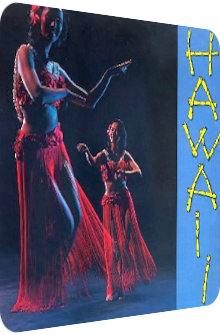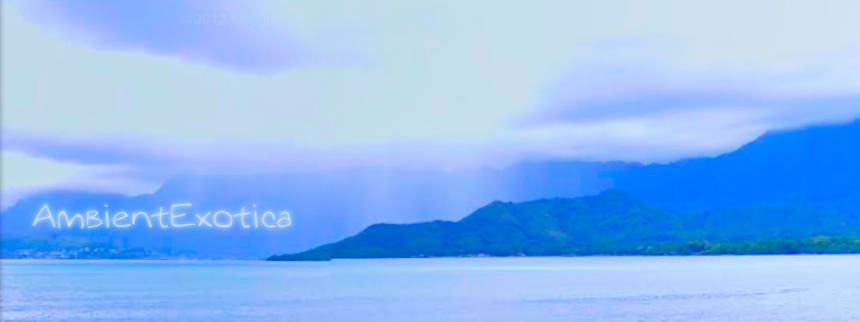
The Surfmen
The Romantic Lure
Of Hawaii
1963
The Romantic Lure Of Hawaii is the second and last album by the Exotica supergroup The Surfmen, released in 1963 on David L. Miller’s Somerset label. If one considers the group’s first album The Sounds Of Exotic Island (1961) which is hailed as one of the most vivacious and multilayered Exotica works of all times, chances are good that their sophomore album offers more of the same bongo beats, tropical birdcalls, paradisiac flutes and gentle piano arrangements, right? Alas, yes. It offers more of the same! This album cannot camouflage the origin of Miller’s Somerset label as a budget label. It is, firstly, reissued under different names and in ever-changing track orders, ranging from titles such as The Surfmen In Hawaii and The Romantic Lure Of Hawaii, comprising eleven or 12 tracks.
Well, arbitrary – or better still: alatoric – naming conventions are quite common; the Crown label, for instance, is notorious for its various titles of Milt Raskin’s Kapu (1959) or Don Ralke’s and Buddy Collette’s Bongo Madness (1957), but The Romantic Lure Of Hawaii has a much bigger problem than just its iridescing track orders and album titles: it recycles its material! A whopping five tracks of eleven are taken from The Surfmen’s debut album. Even worse, the new material that made it onto the album is rather pale, as it is played by a trio instead of a septet or octet. The new cuts are Hapa Haole tunes and thus much more reduced and limited. In-between these tunes, the flamboyant bliss of the debut album shimmers through. If I have not been clear enough, I rephrase the aforementioned bits of information: The Romantic Lure Of Hawaii is a largely recycled album that wants the listener to pay for songs he already purchased via The Sounds Of Exotic Island. As stated before, the Somerset label was a budget label. You would never notice this when you listen to the debut, but here on this album the fact is figuratively screamed at one’s face time and again. Are there any good parts which do not derive from the debut? Let’s see…
Queen Lydia Lili’uokalani‘s classic of the 1860’s, the omnipresent Aloha Oe, is unsurprisingly mandatory on an album with the title The Romantic Lure Of Hawaii. What is surprising, however, is its place as the opener, for this farewell song fits much better in the lower regions of side B. Be that as it may, The Surfmen enchant the listener right from the get-go with a blazingly colorful ukulele strumming. The melody is clearly recognizable in-between the tremolo undulations which are then followed by a lullaby of glinting glockenspiel globs and rhythm ukuleles, with the chorus then being played on the steel guitar in a legato way. A final warped twang with that typical Hawaiian rising glissando ends the little ditty. For those who are fed up with the archetypical Aloha Oe flood of interpretations, The Surfmen find the proper balance between intimate Hapa Haole and little traces of exoticism in the form of the glockenspiel addition.
Next is Richard Rodgers’ and Oscar Hammerstein II.’s Bali Ha’i which immediately lures the listener with its field recording of gentle ocean waves and birds of paradise. The problem: this very version is the first phase of five recycling operations on the album. Taken off The Surfmen’s debut The Sounds Of Exotic Island, the arrangement feels decidedly wider than the intro. Paradisiac flutes, Jack Costanzo’s bongo aorta, steel guitars and guiros as well as refreshing vibraphones make this a high-plasticity version which remains one of my favorites to this day. The percussion layers are truly tropical and sound magnificent, the main melody is dreamy, the flute transfigures it further. Add harp twangs and and magnanimous cymbals to the scenery, and you got a dream come true.
Al Hoffman’s, Charles E. King’s and Dick Manning’s Hawaiian Wedding Song follows and succeeds with delicately frizzling maracas and another glockenspiel dreamscape with added ukuleles and steel guitars. The mallet instrument really sparkles and outshines every warmhearted guitar lick with its sheer luminosity. Robert Lowden’s Jungle Romance follows, the second song taken off The Surfmen’s debut. Things get delightfully exotic here with the jungle field recording of birds and monkeys and the wonderfully laid-back percussion with shells and wind chimes. Female chants and a superbly sleazy-mysterious guitar-vibraphone concoction leads to equally successful, sizzling-hot organ washes and a languorous Martin Denny-esque piano placenta. Robert Lowden is known for his song material he wrote for the 101 Strings, but this tune would not possibly work in an orchestra. One of the best vintage Exotics cuts ever created!
While Alfred Newman’s and Frank Loesser’s Moon Of Manakoora continues the path of recycling but enchants with its wind chime-heavy bongo-backed guitarscape and an unexpected amount of chirping birds who croak the night away in adjacency to the wonderful mélange of mallet instruments and steel guitars, regular Somerset writer Joseph F. Kuhn’s Polynesian Fever widens the instrumental pool with a set of vibraphones, wind chimes and spectral cymbals. The backdrop of birds and animals is again highly appreciated and boosts the paradisiac notions of the languorous piano play and the aquatic glissando of the vibe spirals.
Side B comprises of five tracks, with only one of them being recycled, thus making this side feel somewhat more valuable than side A if seen from the viewpoint of honesty. Alex Anderson’s Love Hula Hands kicks off that side with the expected Hapa Haole gentleness and the triola of steel guitar, ukulele and glockenspiels. Highlights include the Sicilian play style on the steel guitar which then re-enters the Hawaiian orbit with its sparkling appearance. The interpretation of Jack Pitman’s Beyond The Reef resides in the very same climes and lets the rhythm ukulele guitars coalesce with the most genteel fizzles of maracas. The ukulele twangs are surprisingly energetic and resemble that Sicilian tremolo yet again. Only in the last third does the translucent glockenspiel appear, and as a result, the version is less nocturnal-moony than Arthur Lyman’s famous take off his album Hawaiian Sunset (1958).
The utterly gorgeous Orchid Lagoon by Robert Lowden is the final rehashed piece off The Sounds Of Exotic Island and unleashes a phantasmagoria that is supercharged with percussion shells, vibe scintillae, chirping birds, Polynesian flute airflows and silky ukulele twangs. The euphony is huge and matches the carefreeness, the steel guitars float along, in short: Orchid Lagoon is a revelation and one of the very best Exotica cuts that never experienced a cult following, let alone renditions of other groups or conductors. A secret marvel. The album ends with two unique cuts by regular Somerset writer David Kleiber: Hano Hano is an uplifting midtempo shanty with rhythm ukuleles, polyphonous steel guitar layers, the expected glockenspiels and a few pinches of Rock’n Roll and Surf viewed through rose-tinted Hawaiiana glasses, whereas the final Mahala Pua is a downtempo mirage with the same ingredients but wondrously laid-back, coruscating mallet instruments, easygoing maraca grooves and dragonfly-resembling ukulele erections whose changes in dynamics elevate this tune from being yet another Hapa Haole tune.
The Romantic Lure Of Hawaii remains a special case in the world of Exotica, but for bad reasons. While lots of labels tried to cash in on the tourism-related interest in Hawaii, the bongo craze with Afro-Bop accents as well as the birdcall-laden Exotica cuts of the Polynesian kinds, Somerset’s boss David L. Miller makes a particularly audacious move with the sophomore album of The Surfmen. The blending of Hapa Haole with larger orchestras or more convoluted percussion strata has been done numerous times before, for example on Sam Makia’s Hawaii: The Beautiful 50th State (1959) and Santo & Johnny’s simple-titled Hawaii (1961) to name but two examples, with one noteworthy distinction: these albums blended these genres or styles in each of the songs. The Surfmen’s sophomore and last album presents a curious mixture of these styles: septet recordings are followed by trio renditions. You can easily spot the differences in quality: the colorful, multi-faceted and polylayered tunes are without any exception taken from the great opus that is known as The Sounds Of Exotic Island. The ukulele-accentuated glockenspiel-interspersed steel guitar prowess of the Hapa Haole tracks then makes up the second part of the album’s physiognomy.
Even if I look at this second album in a generous manner, The Romantic Lure Of Hawaii is a bold misstep. Naturally, collectors need to own both albums, but Exotica fans who are not as devoted must definitely give the first album a go and skip the second one entirely, for it weaves some of the greatest tunes into its appearance. However, you would then not have experienced the whole exotic grandiloquence of The Sounds Of Exotic Island. As superb the debut album of the supergroup is, the second album is pestered with limited budgets, recycling procedures, the cut of many musicians… and the omission of the previous band! Jack Costanzo is definitely not on board anymore, no conga or bongo is ever featured on the new tracks. None of these is great enough to justify the purchase, I’m afraid. Exotica collectors find The Romantic Lure Of Hawaii on eBay. It has thus far not been digitally reissued.
Exotica Review 392: The Surfmen – The Romantic Lure Of Hawaii (1963). Originally published on Nov. 22, 2014 at AmbientExotica.com.
